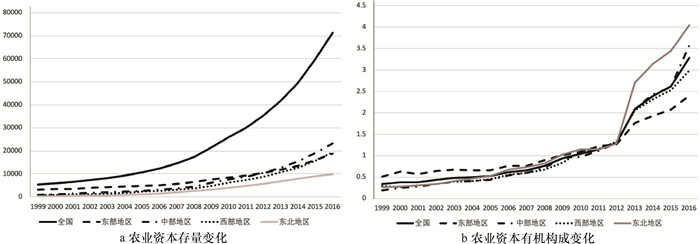Have China's Agricultural Growth Patterns Been Transformed: Based on Empirical Data from 31 Provinces During 1999—2016
-
摘要: 中国农业经济要实现更高阶段增长,需要从依赖投资拉动的马克思增长类型向依靠技术进步的库兹涅茨增长类型转变。基于1999—2016年我国31个省份的数据计算农业资本有机构成、农业资本报酬率和农业全要素生产率,研究发现:观察期内农业资本存量快速上升带动了农业资本有机构成大幅度提高,符合马克思增长类型的基本特征;尽管农业资本报酬率下降,但东部、中部和东北地区的农业资本收入份额均向60%的水平收敛,意味着农业增长步入稳态而未陷入马克思增长类型陷阱;综合四大区域的农业全要素生产率与农业产值增长率、农业资本要素收入份额的关系可以推断,中国农业增长类型已经开始向库兹涅茨增长类型转变。Abstract: If China's agricultural economy is to achieve a higher level of growth, it needs to be transformed from the Marx's growth type that relies on investment to the Kuznets' growth type that relies on technological progress. Based on the data in 31 provinces of China from 1999 to 2016 and the calculation of the organic composition of agricultural capital, rate of return on agricultural capital, growth rate of total factor productivity, it is found that the rapid increase in the stock of agricultural capital during the observation period led to a substantial increase in the organic composition of agricultural capital, which was in line with the basic characteristics of Marx's growth type; though the return of agricultural capital declined, the share of agricultural capital income in the eastern, central and northeastern regions of China converged at the same level of about 60%, which means that agricultural growth has entered a steady state without falling into the trap of Marx's growth type; based on the relationship of the total factor productivity of agriculture in the four regions with the growth rate of gross agricultural output, and the share of agricultural capital factor income, it can be inferred that the type of agricultural growth in China has been transformed to the Kuznets' growth type.
-
表 1 随机前沿模型测算结果
变量 固定效应模型(FIX) 随机效应模型(RND) 时变衰减模型(ECF) lnFit 0.513***(0.171) 0.551***(0.053) 0.492***(0.040) lnLit -0.038(0.087) -0.017(0.038) 0.149***(0.023) lnK_it 0.200***(0.019) 0.201***(0.005) 0.022***(0.006) 常数项 1.889**(0.852) 2.456***(0.397) 2.021***(0.327) η -0.005***(0.001) R2 0.983 似然函数对数值 219.007 500.055 样本数 558 558 558 注:*、* *、* * *分别代表在10%、5%和1%的水平上显著。 -
[1] 速水佑次郎, 神门善久. 发展经济学——从贫困到富裕[M]. 3版. 北京: 社会科学文献出版社, 2009. [2] KUZNETS S. Modern economic growth: rate, structure and spread[M]. New Haven: Yale University Press, 1966. [3] KUZNETS S. Economic growth of nations: total output and production structure[M]. Cambridge, Mass: Harvard University Press, 1971. [4] 速水佑次郎, 神门善久. 农业经济论[M]. 北京: 中国农业出版社, 2003. [5] 罗浩轩. 当代中国农业转型"四大争论"的梳理与评述[J]. 农业经济问题, 2018(5): 33-42. https://www.cnki.com.cn/Article/CJFDTOTAL-NJWT201805006.htm [6] 马克思, 恩格斯. 马克思恩格斯文集: 第五卷[M]. 北京: 人民出版社, 2009: 707. [7] 罗浩轩. 中国农业资本深化对农业经济影响的实证研究[J]. 农业经济问题, 2013(9): 4-14, 110. https://www.cnki.com.cn/Article/CJFDTOTAL-NJWT201309001.htm [8] 李谷成. 资本深化、人地比例与中国农业生产率增长——一个生产函数分析框架[J]. 中国农村经济, 2015(1): 14-30, 72. https://www.cnki.com.cn/Article/CJFDTOTAL-ZNJJ201501004.htm [9] HALL R, JONES C. Why do some countries produce so much more output than others?[J]. Quarterly Journal of Economics, 1999, 114(1): 83-116. doi: 10.1162/003355399555954 [10] 吴方卫. 我国农业资本存量的估计[J]. 农业技术经济, 1999(6): 34-38. https://www.cnki.com.cn/Article/CJFDTOTAL-NYJS199906009.htm [11] 蔡昉. 经济增长方式转变与可持续性源泉[J]. 宏观经济研究, 2005(12): 34-37, 41. https://www.cnki.com.cn/Article/CJFDTOTAL-JJGA200512007.htm [12] 常静雄, 王丹枫, 孙磊. 我国劳动份额变化趋势研究——基于劳动份额、资本回报、投资及就业增长的互动关系分析[J]. 马克思主义研究, 2013(2): 62-72. https://www.cnki.com.cn/Article/CJFDTOTAL-STUD201302010.htm [13] 章上峰, 陆雪琴. 中国劳动收入份额变动: 技术偏向抑或市场扭曲[J]. 经济学家, 2016(9): 15-24. https://www.cnki.com.cn/Article/CJFDTOTAL-JJXJ201609003.htm [14] 谭晓鹏, 钞小静. 中国要素收入分配再测算[J]. 当代经济科学, 2016(6): 7-16, 112. doi: 10.3969/j.issn.1002-2848.2016.06.002 [15] 冯谚晨. 我国劳动收入份额的变动趋势——基于劳资分配失衡的分析[J]. 经济问题探索, 2017(4): 1-9. https://www.cnki.com.cn/Article/CJFDTOTAL-JJWS201704002.htm [16] ROMER P M. Endogenous technological change[J]. Journal of Political Economy, 1990, 98(5): 32-36. [17] BLYTH C A. Economic growth of nations: total output and production structure by Simon Kuznets[J]. Economica New Series, 1973, 40(160): 457-458. doi: 10.2307/2553328 [18] SCHMIDT P, SICKLES R C. Production frontiers and panel data[J]. Journal of Business and Economic Statistics, 1984, 2(4): 367-374. http://www.researchgate.net/publication/4721996_Production_Frontier_and_Panel_Data [19] BATTESE G E, T J COELLI. Frontier production functions, technical efficiency and panel data: with application to paddy farmers in India[J]. Journal of Productivity Analysis, 1992, 3: 153-169. -





 下载:
下载:




